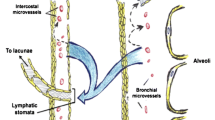Abstract
Background
The aim of this study was to analyze the results of pleurodesis for malignant pleural effusion performed by surgeons.
Patients and methods
A series of 273 patients with malignant pleural effusion underwent thoracoscopy with the aim of performing a palliative pleurodesis. There were 94 males (34.4%) and 175 females (64.1%), ranging in age from 15 to 94 years (mean age: 60.6 years). The effusion was on the right side in 136 patients (49.8%), on the left side in 110 (40.3%), and bilateral in 27 (9.9%). Thoracoscopy was performed under general anaesthesia in all patients. Pleural biopsy was performed in two thirds of the patients (70.7%). Pleurodesis was produced by instillation of 5g of sterile asbestos-free talc; the chest tube was left in place a minimum of 3 days. It was removed when fluid drainage was less than 200 ml/24 h. Patients were usually discharged the day after chest tube removal.
Results
There was no intraoperative mortality. Two patients (0.7%) had intraoperative complications; 17 (6.2%) underwent a bilateral pleurodesis, and 10 (3.7%) had a pericardiopleural window. In 32 patients (11.7%) no pleurodesis was done, either because the lung did not properly re-expand (5.2%), or because of suspected infection, e.g., false membranes (1.9%), or because of multiple adhesions (4.6%). Finally, only 241 patients (88.3%) had a talc poudrage at the time of thoracoscopy. Duration of postoperative pleural drainage ranged between 1 and 11 days (mean: 3.64 days). The postoperative hospital stay ranged from 2 to 21 days (mean: 7.1 days). Pleural empyema occurred in 4 patients (1.5%) and was lethal in one patient. The mean follow-up period was 8.39 (7.2 months, and 172 patients had regular follow up. In this group, there were 24 recurrences (14%), 12 of which were treated by repeat pleurodesis. The results were very good in 133 patients (77.3%), acceptable in 35 patients (20.3%), and there was a failure in 4 patients (2.4%).
Conclusions
Results of surgical thoracoscopy for malignant pleural effusion are good, with low morbidity. However, in debilitated patients, bedside talc slurry may be preferable.

Similar content being viewed by others
References
Antunes G, Neville E, Duffy J, Ali N (2003) BTS guidelines for the management of malignant pleural effusions. Thorax 58(Suppl II): ii29–ii38
Antony V, Loddenkemper R, Astoul P, Boutin C, Goldstraw P, Hott J, Rodriguez Panadero F, Sahn SA (2001) Management of malignant pleural effusions. Eur Respir J 18: 402–419
Bernard A, de Dompsure R, Hagry O, Favre J (2002) Early and late mortality after pleurodesis for malignant pleural effusion. Ann Thorac Surg 74: 213–217
Brant A, Eaton T (2001) Serious complications with talc slurry pleurodesis. Respirology 6: 181–185
Brega-Massone P, Conti B, Magnani B, Ferro F, Lequglie C (2004) Minimally invasive thoracic surgery for diagnostic assessment and palliative treatment in recurrent neoplastic pleural effusion. Thorac Cardiovasc Surg 52: 191–195
Cardillo G, Facciolo F, Carbone L, Regal M, Corzani F, Ricci A, Di Martino M, Martelli M (2002) Long-term follow-up of video-assisted talc pleurodesis in malignant recurrent pleural effusion. Eur J Cardio-Thoracic Surg 21: 302–306
Cohen G, Shely W, Thompson S, Hagen JA, Marboe CC, DeMeester TR, Starnes VA (1996) Talc pleurodesis: talc slurry versus thoracoscopic talc insufflation in a porcine model. Ann Thorac Surg 62: 1000–1004
Erikson K, Yost M, Bynoe R, Almond C, Nottingham J (2002) Primary treatment of malignant pleural effusions: video-assisted thracoscopic surgery poudrage versus tube thoracostomy. Am Surg 68: 955–959
Genc O, Petrou M, Ladas G, Goldstraw P (2000) The long-term morbidity of pleuroperitoneal shunts in the management of recurrent malignant effusions. Eur J Cardio-Thoracic Surg 18: 143–146
Haddad J, Younes R, Gross J, Deheinzelin D (2004) Pleurodesis in patients with malignant pleural effusion: talc slurry or bleomycin? Results of a prospective randomized trial. World J Surg 28: 749–753
Lee Y, Baumann M, Maskell N, Waterer GW, Eaton TE, Davies RJO, Heffner JE, Light RW (2003) Pleurodesis practice for malignant pleural effusions in five English-speaking countries. Survey of pulmonologists. Chest 124: 2229–2238
Migliore M (2003) Efficacy and safety of single-trocar technique for minimally invasive surgery of the chest in the treatment of noncomplex pleural disease. J Thorac Cardiovasc Surg 126: 1618–1623
Rehse D, Aye R, Florence M (1999) Respiratory failure following talc pleurodesis. Am J Surg 177: 437–440
Schulze M, Boehle A, Kurdow R, Dohrmann P, Henne-Bruns D (2001) Effective treatment of malignant pleural effusion by minimal invasive thoracic surgery: thoracoscopic talc pleurodesis and pleuroperitoneal shunts in 101 patients. Ann Thorac Surg 71: 809–812
Vargas F, Antonangelo L, Capelozzi V, Vaz MA, Genofre EH, Marchi E, Teixeira LR (2002) Lung damage in experimental pleurodesis induced by silver nitrate or talc. One-year follow-up. Chest 122: 2122–2126
Waller D, Rengarajan A (2001) Thoracoscopic decortication: a role for video-assisted surgery in chronic postpneumonic pleural empyema. Ann Thorac Surg 71: 1813–1816
Whitlow C, Craig R, Brady K, Hetz S (1996) Thoracoscopic pleurodesis with minocycline vs talc in the porcine model. Surg Endosc 10: 1057–1059
Yim A, Chan A, Lee T, Wan I, Ho J (1996) Thoracoscopic talc insufflation versus talc slurry for symptomatic malignant pleural effusion. Ann Thorac Surg 62: 1655–1658
Author information
Authors and Affiliations
Corresponding author
Additional information
Presented at the 13th Congress of the EAES (European Association for Endoscopic Surgery), Venice, June 2005.
Rights and permissions
About this article
Cite this article
Arapis, K., Caliandro, R., Stern, JB. et al. Thoracoscopic palliative treatment of malignant pleural effusions. Surg Endosc 20, 919–923 (2006). https://doi.org/10.1007/s00464-005-0534-6
Received:
Accepted:
Published:
Issue Date:
DOI: https://doi.org/10.1007/s00464-005-0534-6




